Abstract
Drilling has been conducted to investigate the petrogeochemistry of the Late Pleistocene Guxiangtun Formation and Holocene Wenquanhe Formation in Northeast China. Both Guxiangtun and Wenquanhe Formations are fluvial facies, which are composed mainly of quartz and feldspar, with minor mica and clay minerals. To understand the provenance and tectonic setting of these sediments, geochemical analyses of fifteen selected samples from the drill core have been carried out. Compared to the composition of the upper continental crust (UCC), the sediments exhibit higher SiO2, similar TiO2 and K2O, and lower Fe2O3, MgO, MnO, CaO, and Na2O contents. The bivariant plot of Th/Sc versus Zr/Sc ratios indicates the contribution from recycled sedimentary provenance for our studied sediments; furthermore, the low to medium degree of weathering of these sediments is commonly indicated by the chemical index of alteration (CIA) of 52. The discriminant function diagram using major elements shows a mixed provenance of the sediments, including quartzose sedimentary and felsic igneous rocks. According to the Fe2O3+MgO vs. K2O/Na2O plot and Th–Sc–Zr/10 diagram, the sediments under the investigation fall mostly within the active continent margin field.
1. Introduction
Construction and composition of sediments record significant information about river processes related to flow dynamics, geomorphology, weathering condition, provenance, and tectonic setting [1,2,3,4]. The geochemical compositions of various sediments are widely used to identify their precipitation process involved, and a lot of studies have been carried out on sediments from different ages and places [5,6,7,8,9,10]. The main factor controlling the initial geochemical characteristics of sediments is provenance, and the provenance is again related to regional tectonic setting [1,11]. However, provenance rocks undergo weathering before transport, which has a close relationship with the paleo-climate [4,12,13]. In this process, the sediments keep the original geochemical feature of immobile elements, such as Al, Ti, Sc, rare earth elements (REEs) and so on, and the mobile elements, such Na, K et al., would be removed [14]. During transporting, heavy and light minerals are sorted, resulting in the enrichment of stable heavy minerals, such as zircon. Hence, the geochemical compositions of sediments could be used to deduce the provenance as well as paleo-climate, and tectonic setting of their formation effectively [4,12].
Rivers transport detrital material, and mold the surface through erosion, transport and accumulation [15]. At the same time, the river system can respond sensitively to the changes in external environmental factors, such as climate, structure, and human activities [16,17,18]. Major rivers in the world have been investigated by several geochemists [4,13,19,20]. As one of the seven major river systems in China, the Songhua River system is a unique laboratory related to tectonic setting, topography and climate development [21,22]. Due to the complex provenance distribution of the Songhua River system, the study of provenance is still very limited. Li et al. [15] analyzed the provenance and river process by the composition of heavy minerals from the sediments of Songhua River. The heavy minerals cannot efficiently reflect the weathering degree of the provenance. However, the chemical composition can identify the weathering and sorting process of the river sediments.
In this paper, we present the results of a comprehensive study of the petrography, major, trace, and rare earth elements (REEs) of sand collected from Holocene Wenquanhe and Late Pleistocene Guxiangtun Formations. The aims are to define the geochemical characteristics, weathering conditions, and provenance of these formations, and constrain their tectonic setting in the Quaternary Period.
2. Geomorphologic and Geology Setting
The Songhua River is one of the seven major rivers in China, which is a major tributary of the Amur River (also known as Heilong River, Figure 1a). It flows mainly through the Heilongjiang and Jilin Provinces in China, with a total drainage area of 5.568 × 105 km2 and annual runoff of 7.62 × 1010 m3. The Songhua River has two main headwaters. The north headwater is the Nen River, the largest tributary of the Songhua River, which originates in the Greater Hinggan Mountains. Tributaries of the Nen River include the Dubukuer River, Gan River, Nuomin River, Alun River, Yaru River, and Namur River, etc. The south source for the Songhua River originated from the Tianchi Lake of Changbai Mountain. After the convergence of the two tributaries, the Songhua River extended eastward to Tongjiang and finally flowed into the Amur River. Generally, at Harbin and Jiamusi, the Songhua River is divided into the upstream, midstream, and downstream [22,23,24].
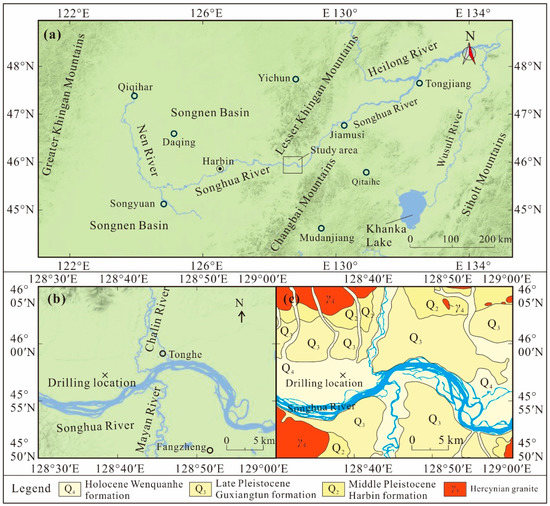
Figure 1.
(a) Satellite map of Songhua River drainage; (b) satellite map of Tonghe area; (c) geology map of Tonghe area cited from BGMRHP [25].
The Songhua River flows through the Songnen Basin in Northeast China. It borders the Greater Khingan Mountains in the west and northwest, the Changbai Mountains in the southeast, and the Lesser Khingan Mountains in the north and northeast (Figure 1a). The rocks from the mountains around the Songnen Basin are mainly intrusive and volcanic rocks, accounting for more than 80% of the exposed terrane. The intrusive rocks are mainly granite and granodiorite, and the volcanic rocks are mainly basalt, andesite, rhyolite, and tuff [25]. The Quaternary sediments are widely distributed in the Songnen Basin, Sanjiang Plain, and shores of Songhua River.
Since the Middle Yanshanian, the Hinggan Mountains uplifted sharply and formed a large fault-depression Songliao Basin [25]. After this geological event, the midstream of the Songhua River distributed along the Yi-Shu Fault, which was active in the Cretaceous in the Heilongjing Province. Since the Cretaceous, sediments up to thousands of meters of thickness were deposited [25]. The 1920 m thick Taoqihe Formation, considered as the bottom of the sediments, is composed of siltstones, sandstones, and conglomerates, and is dated in the Early Cretaceous by the phytoliths, such as Neozamites verchojanensis, Otozamites sp., Elatocladus dongbeiensis and Baiera minima [25]. The Paleocene-Eocene Dalianhe Formation with a thickness of 2000 m overlaid the Taoqihe Formation unconformably. It is a sequence of mudstones and sandstones, interbedded with coal seams, containing plant fossils such as Ainipollenites, Tiliaepollenites, Pinaceae, and Polypodiaceaeporites. The Oligocene Dingshancun Formation overlaid the Dalianhe Formation conformably, which is a sequence of pebbly sandstones, medium sandstones, fine sandstones, and mudstones with lignites. During the Neogene, the crust was uplifted, and the sedimentary discontinuities occurred in the Heilongjiang area. The Quaternary strata are widely developed in the Heilongjiang Province, which could be divided into the early Pleistocene Dongshenjing Formation, middle Pleistocene Harbin Formation, late Pleistocene Guxiangtun Formation, and Holocene Wenquanhe Formation (Figure 1c). The Dongshenjing Formation and Harbin Formation are mainly composed of claystones. According to BGMRHP [25], the Guxiangtun Formation is divided into upper and lower sections. The bottom of the lower section is yellow, sallow or gray in color and consists of sand. The top of the lower section is gray in color and consists of fine sand containing minor clay materials [25]. The upper section is clay and subclay. It shows a complete positive cycle of the sedimentation rhythm. The lower part is river-bed facies sediments, and the upper part is alluvial-pluvial facies sediments. The Guxiangtun Formation is a noted stratum containing coelodonta-mammothus fauna as well as hominid fossils, which is constrained at 70 to 11 thousand years by 14C dating [25]. The Wenquanhe Formation is composited of sand at the bottom, and gray-brown, gray-yellow clay and silt at the top. It contains gastropod fossils, e.g., Gyraulus schmackeri, phytolith, e.g., J. manchurica var. tikunagai and J. manchurica naorai, and fish fossils, and has been precipitated for about 10 thousand years. In the Tonghe area, the Dongshenjing Formation is missing (Figure 1b,c). Moreover, drilling was implemented at the study area, and the drilling column is consistent with the description of BGMRHP [25] but missing the upper section of Guxiangtun Formation (Figure 2).
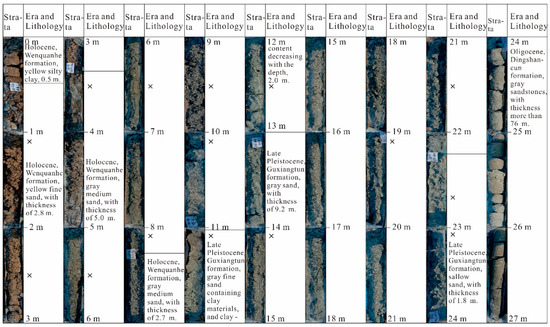
Figure 2.
Drill column and sampling location (× is the sample location).
3. Sampling and Analytical Methods
The strata in the Tonghe area were selected for the present research, because it represents a typical geology section in this area. There is the named place of the Dingshancun Formation and the strata were dated clearly. A SH30-2D crawler drilling machine with geotome was used to collect samples. The drilling location is shown in the Figure 1b,c. Fifteen samples of sand were collected from the Guxiangtun and Wenquanhe Formations, and the location and depth of sample are shown in the Figure 2.
The samples were prepared for thin-section examination at first, and then fresh samples were milled into 200 mesh before analyses of major, trace, and rare earth elements (REEs) at the Resources and Environment Laboratory, Northeast Agricultural University, Harbin, China. The powdered samples about 0.5 g were mixed with seven times the amount of Li2B4O7, and melted, and then loaded on a spectrometer (Philips PW1500) for the analysis of the major elements using X-ray fluorescence with the analytical error less than 1%. For trace element and REE compositional analyses, samples of ca. 50 mg were dissolved in Teflon bombs using a mixture of HF and HNO3 for 48 h at 190 °C, and then analyses were carried out by an inductively coupled plasma mass spectrometer (ICP-MS), standardized with Chinese national rock standards GSR-1 and GSR-3. The analytical errors were less than 5% [26,27,28].
4. Results
4.1. Petrography
As shown in the Figure 2 and Figure 3, the Wenquanhe Formation is composited of clay, fine sand, and medium sand, where particle size gradually increases with depth. Except for the fine sand from the top, the sand of the Wenquanhe Formation is gray. The mineral composition of sand is feldspar (40–55 vol.%), quartz (40–60 vol.%), and sericite (0–5 vol.%) (Figure 3a,b). The accessory minerals, including zircon, titanite, pyrite, and so on, are less than 1 vol.% (Figure 4b). The maximal particle size could reach 2 mm. The sand is mostly poorly sorted, and subangular-subround in nature (Figure 3a,b). A large amount of lithic fragment was observed, which is composed of euhedral feldspar crystal and quartz. The feldspar underwent alteration to some extent, making the surface opaque.
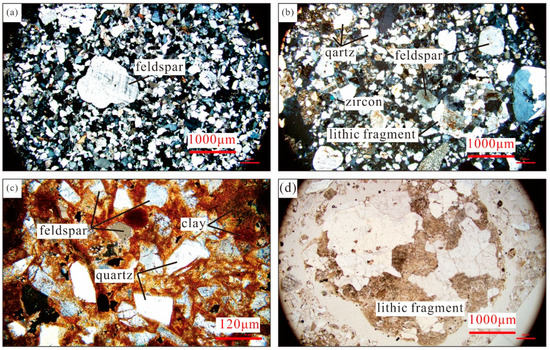
Figure 3.
Microphotos of Quaternary sediments that show the texture and mineral assemblages of the quartzose sediments. (a) Detrital feldspar grain with subangular morphologies indicating a long distance transport, doubly polarized light (Sample SH12–1). (b) Sub-round sand grains showing a poorly sorted, doubly polarized light (Sample SH12–4). (c) Angular detrital fragment and clay minerals implying a short distance transport, doubly polarized light (Sample SH12–10). (d) Sub-round lithic fragment, plane-polarized light (Sample SH12–12).

Figure 4.
(a,b) Geochemical classified graph for the sediments from the Songhua River after Herron [29].
The Guxiangtun Formation is a sequence of arenous sediments, composed of quartz (40–55 vol.%), feldspar (45–60 vol.%), and clay (0–15 vol.%) (Figure 3c). The clay materials only occur in the top section (Figure 3c), and gradually decrease downward. The sand is moderately sorted, with an angular grain size. The particle size is about 0.2 mm for fine sand, and 1.5 mm for coarse sand. Sub-round lithic fragments were commonly found in the Wenquanhe and Guxiangtun Formations (Figure 3d).
4.2. Major Elements
The major element compositions of the sedimentary strata are listed in Table 1. The Wenquanhe Formation and Guxiangtun Formation yield similar chemical compositions. The sediments from the Wenquanhe and Guxiangtun Formation have SiO2 contents of 69.62–77.03 wt.% (average 74.35 wt.%) and 67.32–78.17 wt.% (average 75.16 wt.%), respectively. The Al2O3 content of sediments are 9.72–15.03 wt.% (average 11.67 wt.%) and 9.37–15.60 wt.% (average 11.11 wt.%), which exhibit variations with the content of clay minerals. The high SiO2 and Al2O3 contents indicate a higher compositional maturity. Compared to the upper continental crust (UCC) [30], the sand compositions exhibit similar TiO2 and K2O contents. Moreover, they are depleted in other major elements, such as Fe2O3, MgO, MnO, CaO, and Na2O.

Table 1.
The major and trace elements of sediments from the Songhua River.
Major element compositions are often employed in the classification of sedimentary rocks to distinguish mature from immature rocks [31]. For example, the SiO2/Al2O3 ratio [32] reflects the relative abundance of quartz vs. clay or feldspar, while the Fe2O3/K2O ratio allows for better identification of arkoses from litharenite [29]. The log(SiO2/Al2O3) vs. log(Na2O/K2O), and log(SiO2/Al2O3) vs. log(Fe2O3/K2O) diagrams show that most of the sand samples from the Songhuajiang River fall in the litharenite and arkoses field (Figure 4). The composition of the sand is arkoses.
4.3. Trace Elements
Trace element data of the sand from Songhua River are listed in Table 1. The samples have homogeneous trace element concentrations, and the distinction between Wenquanhe Formation and Guxiangtun Formation is inappreciable. Compared to the upper continental crust (UCC) [30], the sediments are moderately depleted in Zn, Ba, Sr, Nb, and Ta, and moderately enriched in Th. The elements of Sc, Cr, Co, La, Ce, Pr, Nd, W, and U are slightly depleted. The other elements, e.g., V, Ni, Cu, Y, Zr, Cs, Sm, Eu, Gd, Tb, Dy, Ho, Er, Tm, Yb, Lu, Hf, and Pb, are slightly enriched. The sediments have a low Nb/Ta ratio and high Th/U ratio, indicating a strongly differentiated source.
The Wenquanhe and Guxiangtun Formations have very similar rare earth element patterns, so they were described together here. The REEs of sediments are approximate to the UCC, and the REE concentrations generally range from 95 to 208 ppm. The sediments are also characterized by LREE-enriched chondrite normalized REE patterns (Figure 5) and moderate negative Eu anomalies (δEuN = 0.66, δEuN = EuN/(SmN/GdN)1/2) without Ce anomalies, and these patterns resemble that of the upper continental crust [33]. Moreover, in contrast to the UCC, the sediments exhibit a slight HREE enrichment with an LREE/HREE ratio of 7.7 and LaN/YbN ratio of 8.5.
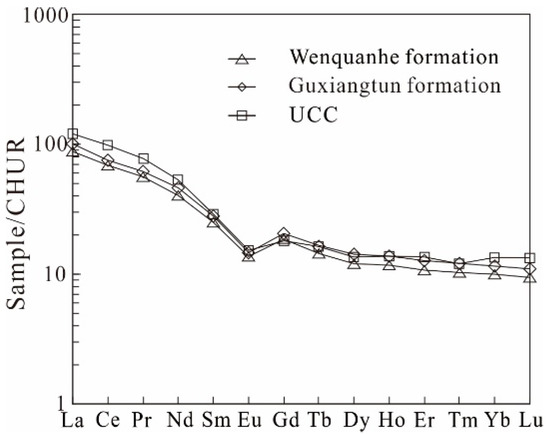
Figure 5.
Chondrite normalized rare earth element patterns of sediments from the Songhua River [33].
5. Discussion
5.1. Sediment Maturity, Weathering and Sorting
Source composition, chemical weathering and hydrological differentiation processes control the chemical composition of sedimentary suites together [12,34]. With the increase in sediment maturity, there is an increase in quartz mineral instead of feldspar, mafic minerals, and lithic fragments in sediments, resulting in an increase in SiO2 and decrease in other major elements, such as Al2O3, Na2O, K2O, MgO, Fe2O3, and CaO. The Na2O/K2O and Fe2O3/K2O ratios indicate the differentiation of orthoclase and Fe and Na-bearing minerals [29]. The sediments from the Songhua River have higher SiO2/Al2O3 (4.32 to 8.34 averaged at 6.75) and K2O/Na2O (0.85 to 2.88 averaged at 1.41) ratios than that of UCC (4.34 and 0.87), implying a higher compositional maturity. Both the Wenquanhe Formation and Guxiangtun Formation exhibit an increasing trend of compositional maturity upwards, reflected by changes in the SiO2/Al2O3 and K2O/Na2O ratios. These conclusions could also be proved by lower Fe2O3/K2O ratios, which range from 0.39 to 1.05.
Moreover, the maturity and composition variations in sediments from the Songhua River have been influenced by the chemical weather process, as indicated by the chemical index of alteration (CIA). The CIA values of the sediments from the Songhua River range between 47 and 64 (Table 1), which is more than the CIA value of the UCC (about 46). In the A-CN-K diagram (Figure 6), the sediments follow the trend of the chemical weathering process, implying that the sediments have undergone a certain degree of chemical weathering. From the bottom to the top, the CIA values of the Wenquanhe and Guxiangtun Formations show an increased trend, indicating a gradual weathering of the source regions. The CIA variation in sediments from the Songhua River is mainly or partly controlled by lithology, because the sediments with a higher weathering degree have much more fine grains and clay materials. According to fossils of woolly rhinoceros and mammoth, the climate in the research area became cold from the early-middle Late Pleistocene to the late Late Pleistocene Epoch when the Guxiangtun Formation was deposited, and it became warm after the beginning of Holocene [25]. The climate during the last 2 Ma would influence the compositions of the sediments [35]. So, the climate factor that influenced the chemical weathering in the research area is a long-term action.
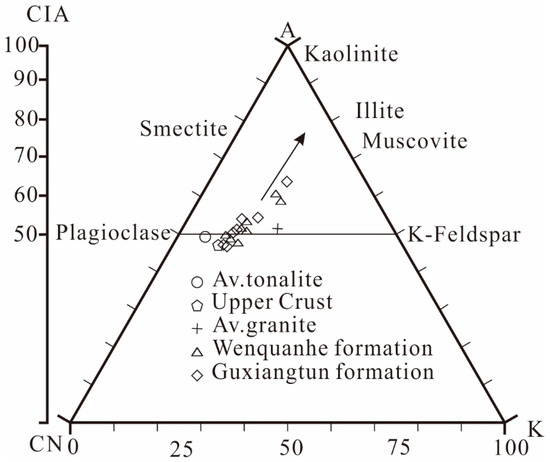
Figure 6.
The chemical index alteration (CIA) of the Guxiangyun and Wenquanhe Formations.
As discussed in petrography, the detrital grains from the sediments are mainly subangular and subround, and the sediments are poorly sorted. To describe the sorting of sediments, the Th/Sc vs. Zr/Sc plot is adopted (Figure 7). The immobile elements, such as Th, Sc and Zr, have a short residence time in water, and are almost quantitatively transferred into the sediments [29]. For the magmatic rocks, the ratio of log (Th/Sc) vs. log (Zr/Sc) is about 1.93. In contrast, if zircon grains were added into the sediments, this ratio would be decreased steeply. Typically for UCC, the ratio of Th/Sc is ~1 and for granitic rocks, the ratios are still higher. In Figure 7, the sediments are characterized by uniform Th/Sc (1.3–2.5) and slightly variable Zr/Sc (9.6–20.5) ratios. These data suggest that the sandstones were slightly enriched with zircon, indicting sorting during transport.

Figure 7.
The Th/Sc vs. Zr/Sc ratios plot for the Guxiangyun and Wenquanhe Formations.
5.2. The Provenance of the Songhua River
The variable size, roundness, and morphology of particles (Figure 3a–c) indicate that the protoliths of the Songhua River sand belonged to multiple terranes that involved weathering and sorting. Roser and Korsch [36] provided a convenient scheme to determine the provenance of sediments, in which concentrations of major elements were used. In the discriminant function diagram after Roser and Korsch [36], most of the samples fall within the quartzose sedimentary field (Figure 8), and part of the samples fall within the felsic igneous provenance field. Sorting and weathering would make provenance deviate from felsic igneous provenance [37], so the provenance may contain more felsic igneous materials.
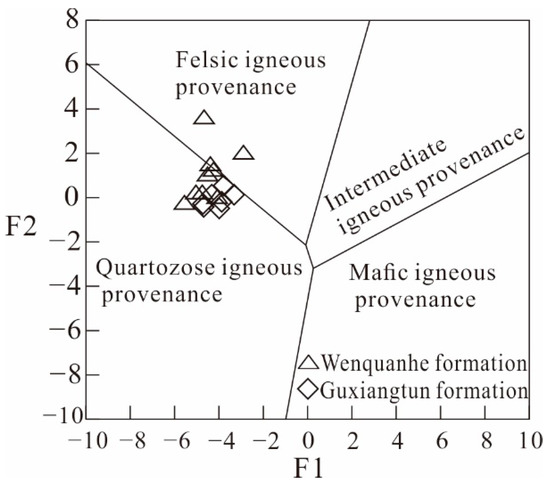
Figure 8.
Classification plot of discriminant functions F1 and F2 for the Songhua River sediments. Provenance fields are from Roser and Korsch [36].
The tetrad effect in geochemical processes has aroused the interest of many scientists, which can be attributed to some genetic models such as mineral fractionation, REE complex, fluid/rock interaction, surficial weathering, and hydrothermal alteration [38]. The computed values for each tetrad are T1 (La-Nd), T2 (Gd-Ho), and T3 (Er-Lu), which were computed using the following equation [39]:
where XAi is the chondrite-normalized concentration of the first element in tetrad i, XBi and XCi are the concentrations of the central elements, and XDi is the chondrite-normalized concentration of the last element in the tetrad. The value of Ti was calculated from all three tetrads. The T1, T2 and T3 values for samples are in the range of 0.02–0.20 (average of 0.10), 0.03–0.27 (average of 0.11), and 0.01–0.13 (average of 0.05), respectively, demonstrating a slight and inappreciable tetrad effect for the samples. Therefore, the REE could effectively be used to constrian provenance of the sediments from the Songhua River.
Low contents of V and Sc imply that the sands were sourced from the continental crust or craton [1]. Chondrite-normalized REE patterns of the sandstones (Figure 5) are similar to those for the upper continental crust [40]. An upper continental crust provenance can be recognized as the main source of the sandstones, based on trace element and REE compositions. The sediments have similar REE contents to UCC, enrichment in LREEs (LREE/HREE = 7.7), no Ce anomaly, and negative Eu anomalies (δEu = 0.67). All evidences prove that the provenance of the Songhua River sediments is a suite of strongly differentiated rocks, part of which may undergo secondary transport. During the transport by the river, primary classic fragments would be mixed with newly added materials. The source for the large river, such as the Songhua River, would be variable along the river. As far as the Songhua River, the lithic fragment of granite shown in the Figure 3d is a reliable evidence of felsic provenance. Meanwhile, the quartz and feldspar grains with moderate psephicity may be products of secondary deposition. According to the location of the research area, it was concluded that both the Lesser Khingan Mountains and Songliao Basin provide the provenance for the Songhua River.
5.3. The Tectonic Setting
The major and trace element compositions of sediments have been widely used to identify the tectonic setting of their deposition [1,8,10,29,38]. According to the Fe2O3+MgO vs. K2O/Na2O diagram [41], the sediments from the Songhua River were plotted mostly close to the field of the active continent margin (Figure 9a). In addition to major elements, immobile trace elements with stable geochemical characteristics (e.g., Th, Sc, and Zr) had been used to identify the tectonic setting of sediments [1,8,10]. On the Th–Sc–Zr/10 diagram (Figure 9b) [1], the sediments fall into or near the field of the active continental margin.
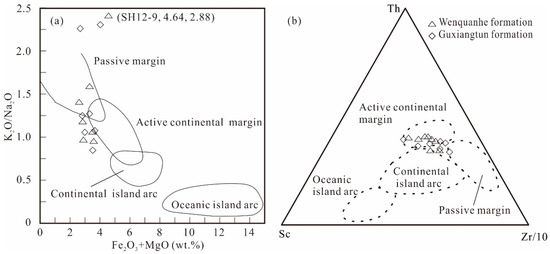
Figure 9.
(a) Tectonic discrimination diagram of major elements for sandstones [38]. (b) Th–Cc–Zr/10 triangular discrimination plot [1].
In the research area, a series of granitiods formed in the Late Paleozoic to Mesozoic are distributed along both sides of the Songhua River, indicating that the Lesser Hinggan-Zhangguangcailing mountains were an active continental margin environment during late Paleozoic to Mesozoic [42]. The sediments exhibit characteristics of the active continental margin. In the river, the feature of provenance maintains stability for a distance. Whereafter, it is diluted by materials from the downstream, making primary provenance information ambiguous. The response of river sediments to the tectonic setting is inherited and delayed, and the sediments are synergistically controlled by the tectonic settings of the upstream and proximal river.
6. Conclusions
According the petrographic observations and geochemical studies, the deposit process, provenance, and tectonic setting of the Late Pleistocene–Holocene sediments from the Songhua River were discussed, and the conclusions are listed as follows:
- (1)
- The sediments from the Guaixngtun and Wenquanhe Formations are composed mainly of quartz and feldspar, with minor mica and clay mineral, and there is no obvious distinction between them.
- (2)
- The CIA values of the sediments from the Songhua River range between 47 and 64, indicating slight chemical weathering. In addition, the sediments are slightly sorted during transport due to uniform Th/Sc and slightly variable Zr/Sc ratios.
- (3)
- Geochemical evidence proves that the provenance of Songhua River sediments is a suite of strongly differentiated rocks, part of which may undergo secondary transport. Both the Lesser Khingan Mountains and Songliao Basin provided the provenance for the Songhua River.
- (4)
- The sediments exhibit characteristics of the active continental margin mainly.
Author Contributions
Conceptualization by W.K., M.S. and M.S.; investigation by W.K. and M.S.; formal analysis by W.K. and L.Y.; writing, review and editing were performed by all authors; and funding acquisition by W.K. and Z.Y. All authors have read and agreed to the published version of the manuscript.
Funding
This study is supported financially by the Application of Multi-electrode Resistivity Geophysical Method at Low Temperature (NAU20220105A).
Institutional Review Board Statement
Not applicable.
Informed Consent Statement
Not applicable.
Data Availability Statement
Not applicable.
Acknowledgments
Thanks to Engineer Jian Yu for his help during the sample collection.
Conflicts of Interest
The authors declare no conflict of interest.
References
- Bhatia, M.R.; Crook, K.A.W. Trace element characteristics of graywackes and tectonic setting discrimination of sedimentary basins. Contrib. Mineral. Petrol. 1986, 92, 181–193. [Google Scholar] [CrossRef]
- Pandey, S.K.; Singh, A.K.; Hasnain, S.I. Grain-size distribution, morphoscopy and elemental chemistry of suspended sediments of Pindari Glacier, Kumaon Himalaya, India. Hydrol. Sci. 2002, 472, 213–226. [Google Scholar] [CrossRef] [Green Version]
- Wang, Y.; Traore, S.; Kerh, T. Monitoring event-based suspended sediment concentration by artificial neural network models. WSEAS Trans. Comput. 2008, 75, 359–368. [Google Scholar] [CrossRef]
- Bhuiyan, M.A.H.; Rahman, M.J.J.; Dampare, S.B.; Suzuki, S. Provenance, tectonics and source weathering of modern fluvial sediments of the Brahmaputra–Jamuna River, Bangladesh: Inference from geochemistry. J. Geochem. Explor. 2011, 111, 113–137. [Google Scholar] [CrossRef]
- Ishiga, H.; Dozen, K.; Sampei, Y. Geochemical constraints on marine invasion and provenance change related to the opening of the Japan Sea: An example from the Lower Miocene shales in the Hoda section, Shimane Peninsula, SW Japan. J. Asian Earth Sci. 1999, 17, 443–457. [Google Scholar] [CrossRef]
- Paikaray, S.; Banerjee, S.; Mukherji, S. Geochemistry of shales from the Paleoproterozoic to Neoproterozoic Vindhyan Supergroup: Implications on provenance, tectonics and paleoweathering. J. Asian Earth Sci. 2008, 32, 34–48. [Google Scholar] [CrossRef]
- Raza, M.; Khan, A.; Bhardwaj, V.R.; Rais, S. Geochemistry of Mesoproterozoic sedimentary rocks of upper Vindhyan Group, southeastern Rajasthan and implications for weathering history, composition and tectonic setting of continental crust in the northern part of Indian shield. J. Asian Earth Sci. 2012, 48, 160–172. [Google Scholar] [CrossRef]
- Saminpanya, S.; Duangkrayom, J.; Jintasakul, P.; Hanta, R. Petrography, mineralogy and geochemistry of Cretaceous sediment samples from western Khorat Plateau, Thailand, and considerations on their provenance. J. Asian Earth Sci. 2014, 83, 13–34. [Google Scholar] [CrossRef]
- Grimes, C.B.; Wooden, J.L.; Cheadle, M.J.; John, B.E. “Fingerprinting” tectono-magmatic provenance using trace elements in igneous zircon. Contrib. Mineral. Petrol. 2015, 17, 46. [Google Scholar] [CrossRef]
- Kassi, A.M.; Grigsby, J.D.; Khan, A.S.; Kasi, A.K. Sandstone petrology and geochemistry of the Oligocene–Early Miocene Panjgur Formation, Makran accretionary wedge, southwest Pakistan: Implications for provenance, weathering and tectonic setting. J. Asian Earth Sci. 2015, 105, 192–207. [Google Scholar] [CrossRef]
- McDonough, W.F.; Sun, S.S. The composition of the Earth. Chem. Geol. 1995, 120, 223–253. [Google Scholar] [CrossRef]
- Singh, P. Major, trace and REE geochemistry of the Ganga River sediments: Influence of provenance and sedimentary processes. Chem. Geol. 2009, 266, 251–264. [Google Scholar] [CrossRef]
- Singh, P. Geochemistry and provenance of stream sediments of the Ganga River and its major tributaries in the Himalayan region, India. Chem. Geol. 2010, 269, 220–236. [Google Scholar] [CrossRef]
- McLennan, S.M. Rare earth elements in sedimentary rocks; influence of provenance and sedimentary processes. Rev. Mineral. Geochem. 1989, 21, 169–200. [Google Scholar]
- Li, S.; Xie, Y.; Chi, Y.; Kang, C.; Sun, L.; Wu, P. Influence of provenance-river process-chemical weathering on heavy mineral composition of the Songhua River sediment. Chin. J. Geol. 2022, 57, 207–229. [Google Scholar]
- Gregory, K.J.; Park, C. Adjustment of river channel capacity downstream from a reservoir. Water Resour. Res. 1974, 10, 870–873. [Google Scholar] [CrossRef]
- Carretier, S.; Nivière, B.; Giamboni, M.; Winter, T. Do river profiles record along-stream variations of low uplift rate? J. Geophys. Res. Earth Surf. 2006, 111, 285–293. [Google Scholar] [CrossRef] [Green Version]
- Gregory, K.J. The human role in changing river channels. Geomorphology 2006, 79, 172–191. [Google Scholar] [CrossRef]
- Singh, M.; Sharma, M.; Tobschall, H.J. Weathering of the Ganga alluvial plain, northern India: Implications from fluvial geochemistry of the Gomati River. Appl. Geochem. 2005, 20, 1–21. [Google Scholar] [CrossRef]
- Zhang, X.; Dalrymple, R.W.; Yang, S.Y.; Lin, C.M.; Wang, P. Provenance of Holocene sediments in the outer part of the Paleo-Qiantang River estuary, China. Mar. Geol. 2015, 366, 1–15. [Google Scholar] [CrossRef]
- Wu, P.; Xie, Y.; Kang, C.; Chi, Y.; Wei, Z.; Wang, J.; Zhang, M.; Zhang, Y.; Liu, L. The capture of the Songhua River system in the late Early Pleistocene: Geochemical and sedimentological records. Acta Geol. Sin. 2020, 94, 3144–3160. [Google Scholar]
- Xie, Y.; Kang, C.; Chi, Y.; Wu, P.; Wei, Z.; Wang, J.; Sun, L. Reversal of the middle-upper Songhua River in the late Early Pleistocene, Northeast China. Geomorphology 2020, 369, 107373. [Google Scholar] [CrossRef]
- Sun, Z.; Jia, C. Discussion on the construction of flood storage and detention area in Songhua River Basin. Northeast Water Resour. Hydropower 2007, 25, 31–33. [Google Scholar]
- Wang, J.; Xie, Y.; Kang, C.; Chi, Y.; Wu, P.; Wei, Z.; Sun, L. The indication of the heavy mineral characteristics of the core in Harbin Huangshan to the Quaternary drainage evolution of Songhua River. Quat. Sci. 2020, 40, 79–94. [Google Scholar]
- Burean of Geology and Mineral Resources of Heilongjiang Province (BGMRHP). Regional Geology of Heilongjiang Province, 3rd ed.; Geological Publishing House: Beijing, China, 1993; pp. 1–190. [Google Scholar]
- Liu, Y.; Liu, H.C.; Li, X.H. Simultaneous and precise determination of 40 trace elements in rock samples using ICP-MS. Geochimica 1996, 25, 552–558. [Google Scholar]
- Liang, X.R.; Li, X.H.; Liu, Y.; Li, J.Y. Ablation microprobe-inductively coupled plasma mass spectrometry: A new method for rapid determination of multiple elements in rock samples. Instrum. Anal. 2000, 19, 33–36. [Google Scholar]
- Li, X.H.; Liu, Y.; Tu, X.L.; Hu, G.Q.; Zheng, W. Precise determination of chemical compositions in silicate rocks using ICP-AES and ICP-MS: A comparative study of sample digestion techniques of alkali fusion and acid dissolution. Geochimica 2002, 31, 289–294. [Google Scholar]
- Herron, M.M. Geochemical classification of terrigenous sands and shales from core or log data. J. Sediment. Petrol. 1988, 58, 820–829. [Google Scholar]
- Taylor, S.R.; McLennan, S.M. The Continental Crust: Its Composition and Evolution, 1st ed.; Blackwell: Oxford, UK, 1985; p. 312. [Google Scholar]
- Das, B.K.; Al-Mikhlafi, A.S.; Kaur, P. Geochemistry of Mansar Lake sediments, Jammu, India: Implication for source-area weathering, provenance, and tectonic setting. Asian Earth Sci. 2006, 26, 649–668. [Google Scholar] [CrossRef]
- Potter, P.E. Petrology and chemistry of modern big river sands. J. Geol. 1978, 86, 423–449. [Google Scholar] [CrossRef]
- Masuda, A.; Nakamura, N.; Tanaka, T. Fine structures of mutually normalized rare-earth patterns of chondrites. Geochim. Cosmochim. Acta 1973, 37, 239–248. [Google Scholar] [CrossRef]
- Dypvik, H.; Riber, L.; Burca, F.; Rüther, D.; Jargvoll, D.; Nagy, J.; Jochmann, M. The Paleocene–Eocene thermal maximum (PETM) in Svalbard—Clay mineral and geochemical signals. Palaeogeogr. Palaeoclimatol. Palaeoecol. 2011, 302, 156–169. [Google Scholar] [CrossRef]
- Harald, G.D. Trends and Composition—A Sedimentological-Chemical-Mineralogical Approach to Constrain the Origin of Quaternary Deposits and Landforms—From a Review to a Manual. Geosciences 2022, 12, 24. [Google Scholar]
- Roser, B.P.; Korsch, R.J. Provenance signatures of sandstone–mudstone suites determined using discriminant function analysis of major-element data. Chem. Geol. 1988, 67, 119–139. [Google Scholar] [CrossRef]
- Roser, B.P.; Ishiga, H.; Lee, H.K. Geochemistry and provenance of Cretaceous sediments from the Eusing block, Gyeongsang Basin, Korea. Mem. Geol. Soc. Jpn. 2000, 57, 155–170. [Google Scholar]
- Abedini, A.; Azizi, M.R.; Dill, H.G. Formation mechanisms of lanthanide tetrad effect in limestones: An example from Arbanos district, NW Iran. Carbonates Evaporites 2020, 35, 1. [Google Scholar] [CrossRef]
- Monecke, T.; Kempe, U.; Monecke, J.; Sala, M.; Wolf, D. Tetrad effect in rare earth element distribution patterns: A method of quantification with application to rock and mineral samples from granite-related rare metal deposits. Geochim. Cosmochim. Acta 2002, 66, 1185–1196. [Google Scholar] [CrossRef]
- McLennan, S.M.; Hemming, S.M.; McDaniel, D.K.; Hanson, G.N. Geochemical approaches to sedimentation, provenance and tectonics. Geol. Soc. Am. Spec. Pap. 1993, 284, 21–40. [Google Scholar]
- Bhatia, M.R. Plate tectonics and geocheical composition of sandstone. J. Geol. 1983, 91, 611–627. [Google Scholar] [CrossRef]
- Ge, M.; Zhang, J.; Liu, K.; Wang, M.; Li, Z. Petrogenesis of the Late Paleozoic to Mesozoic granite from the Xiao Hinggan Mountains-Zhangguangcai Mountains and its geological implications. Acta Petrol. Mineral. 2020, 39, 385–405. [Google Scholar]
Publisher’s Note: MDPI stays neutral with regard to jurisdictional claims in published maps and institutional affiliations. |
© 2022 by the authors. Licensee MDPI, Basel, Switzerland. This article is an open access article distributed under the terms and conditions of the Creative Commons Attribution (CC BY) license (https://creativecommons.org/licenses/by/4.0/).